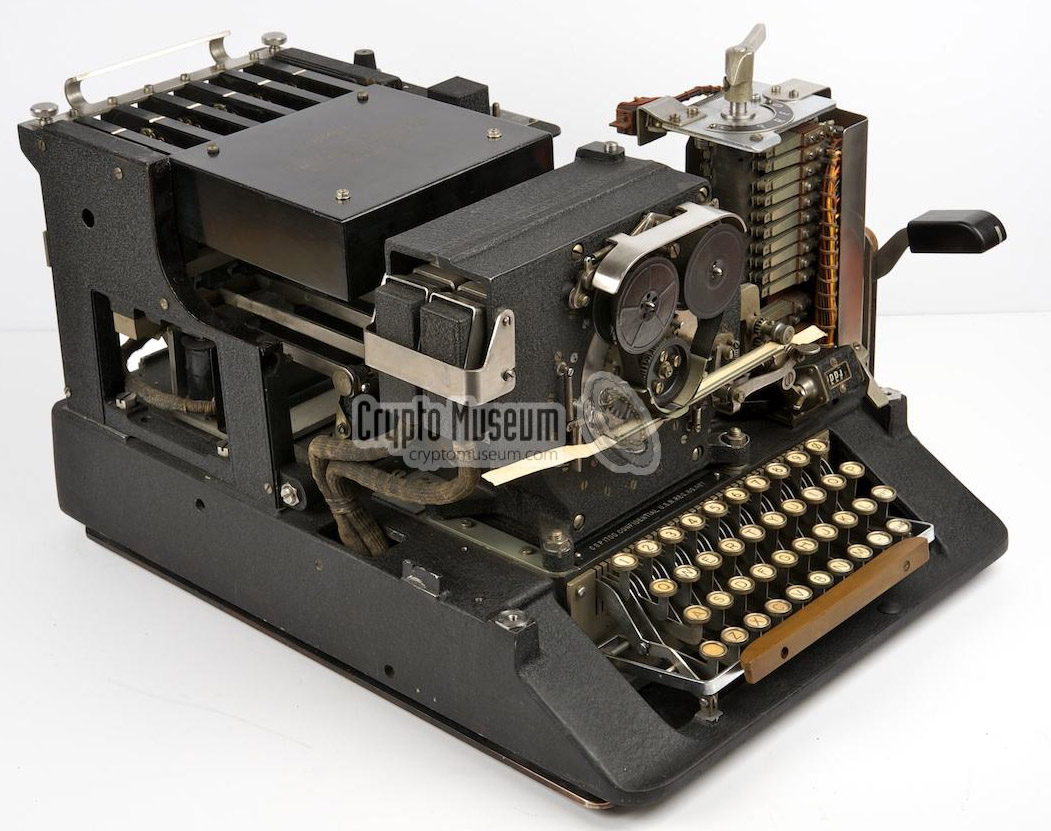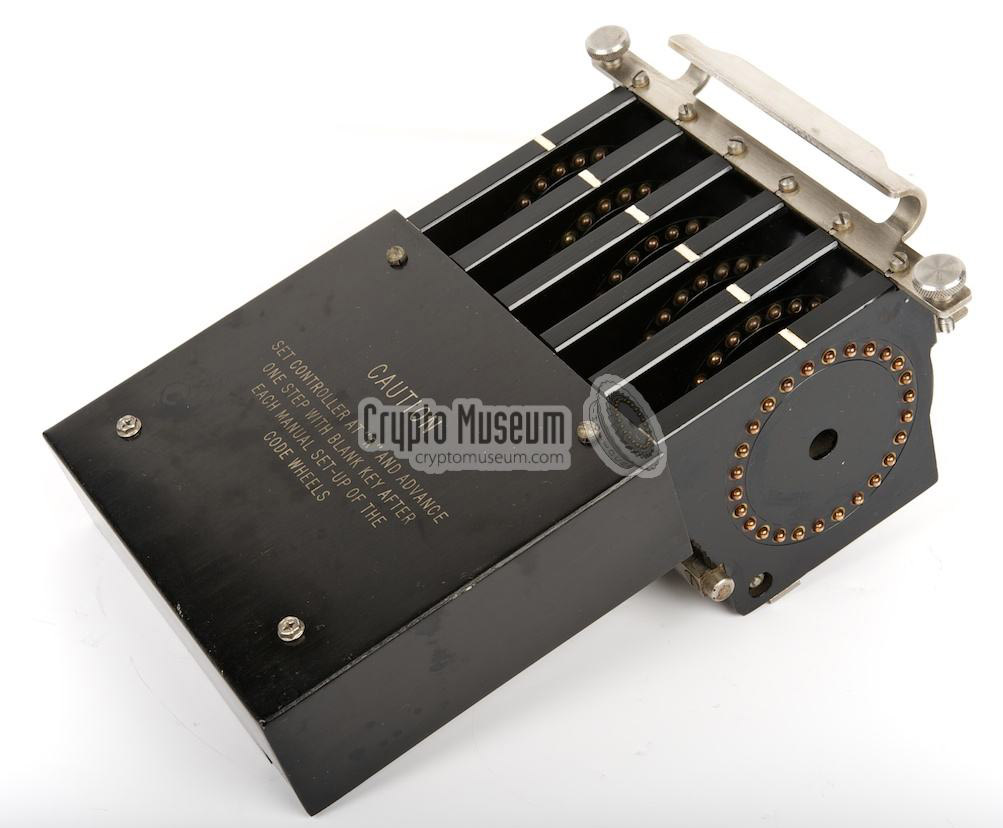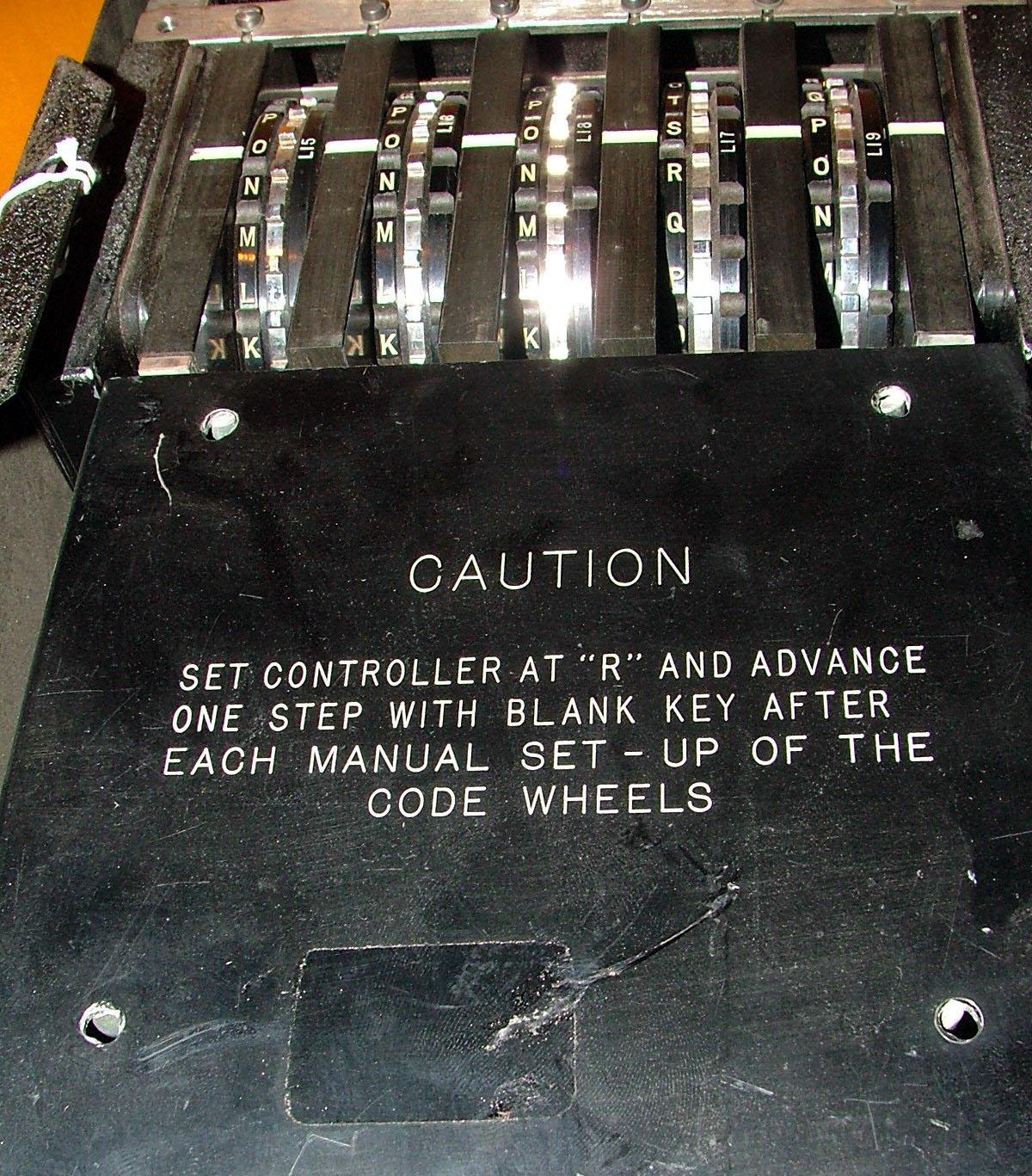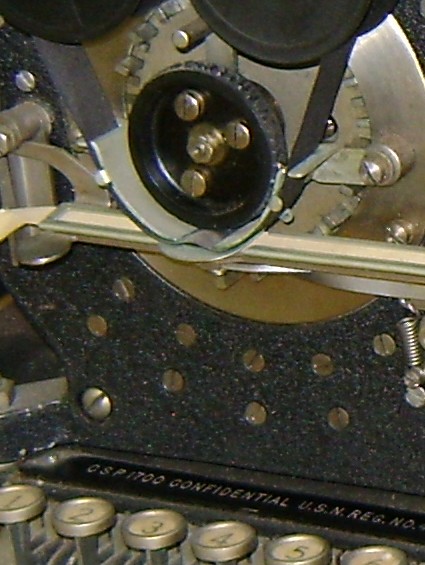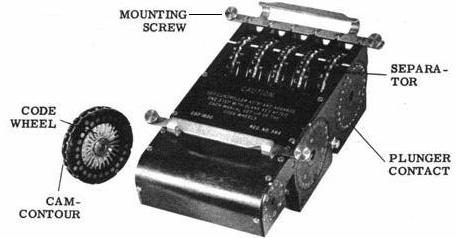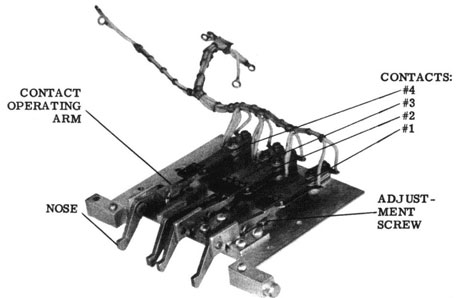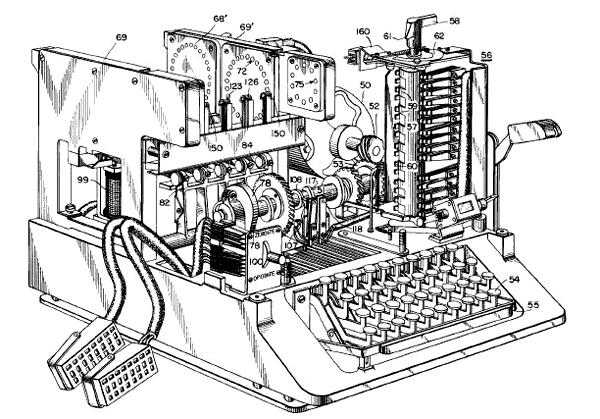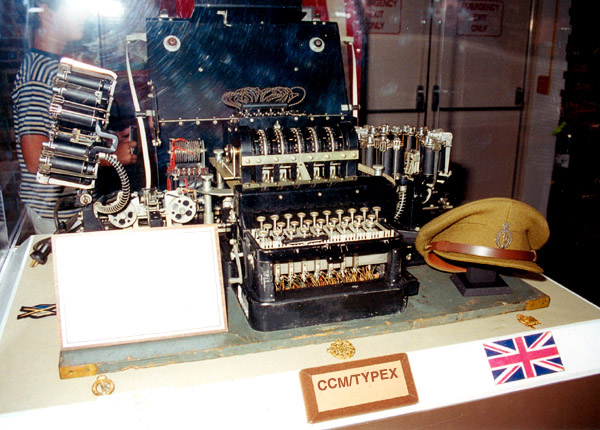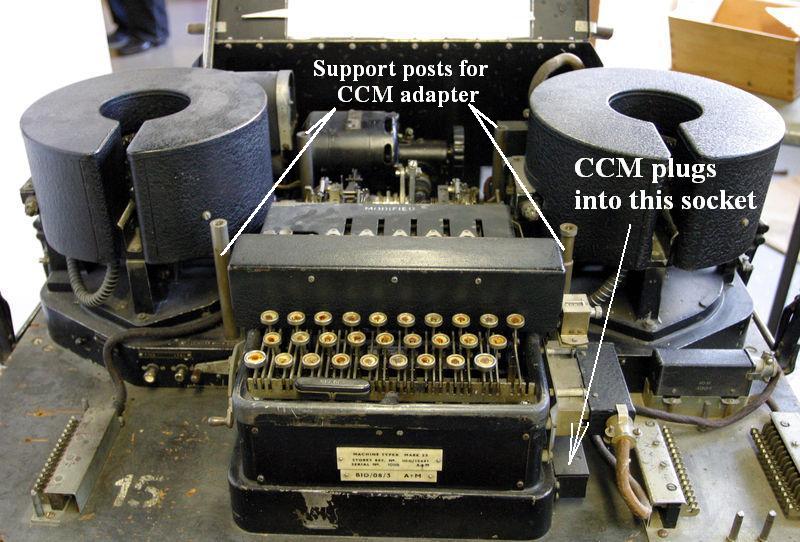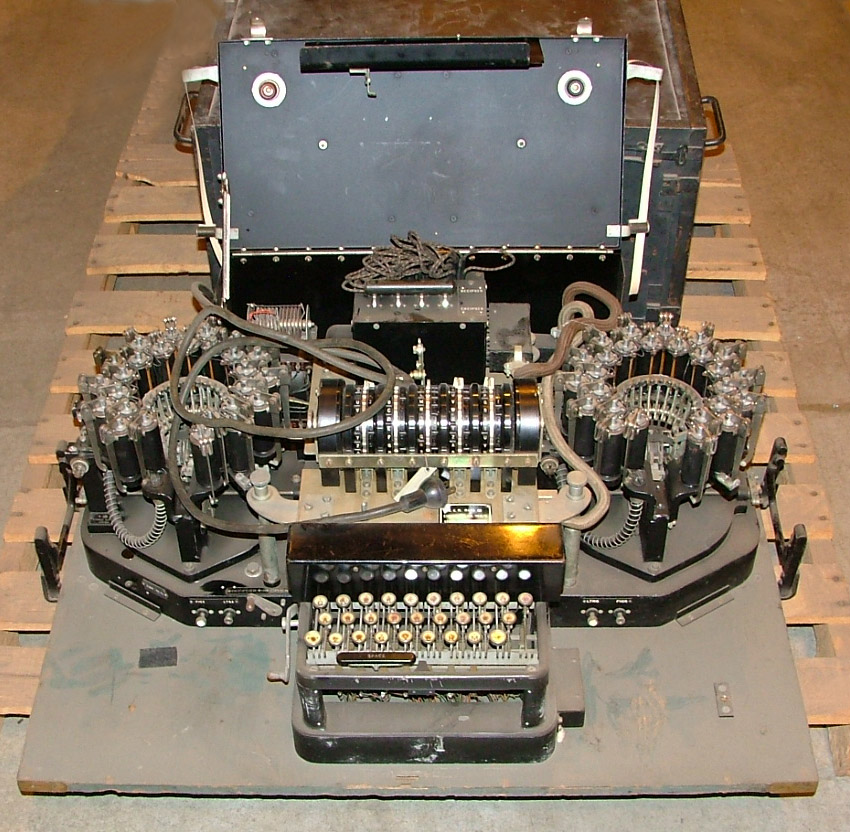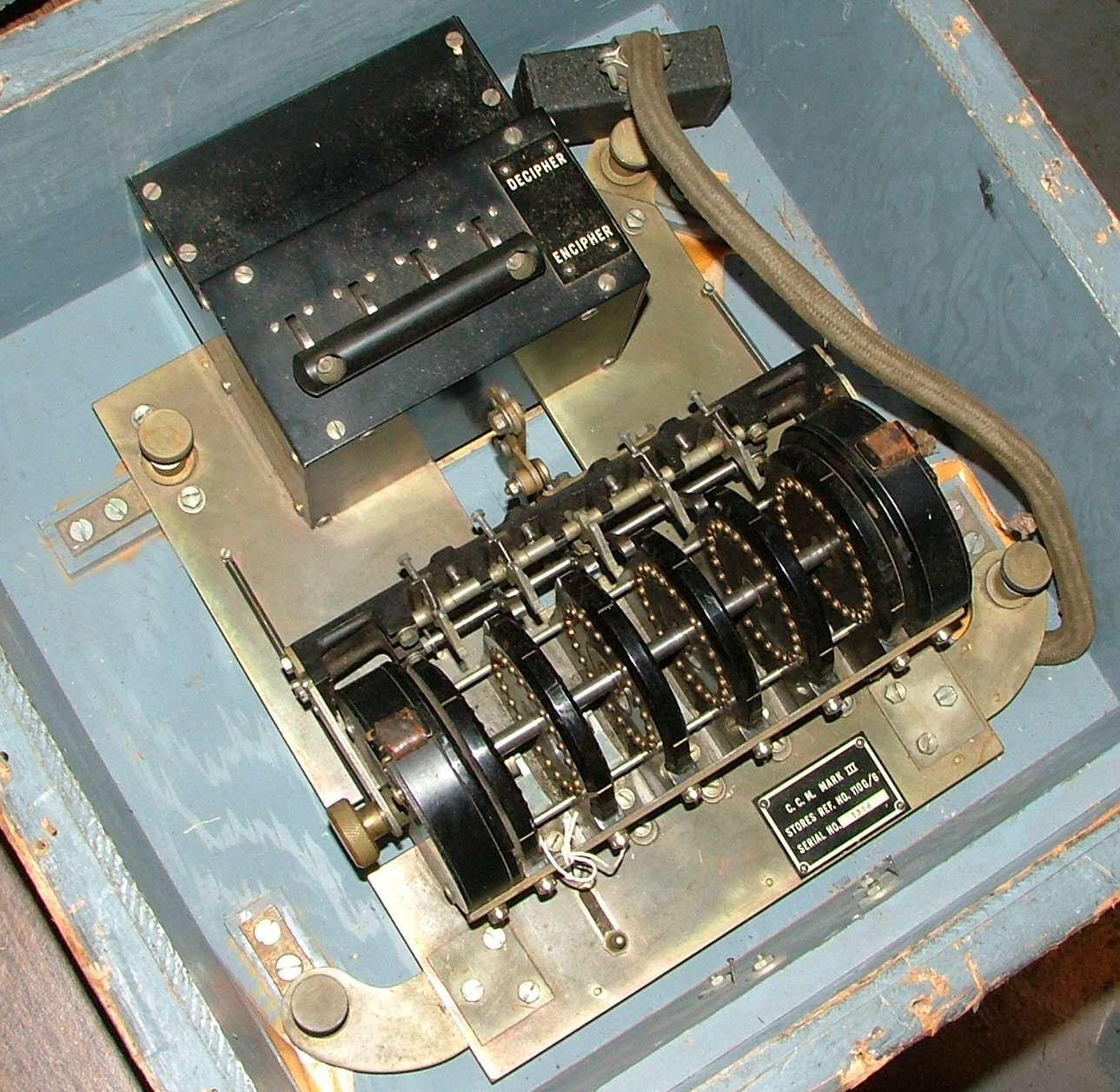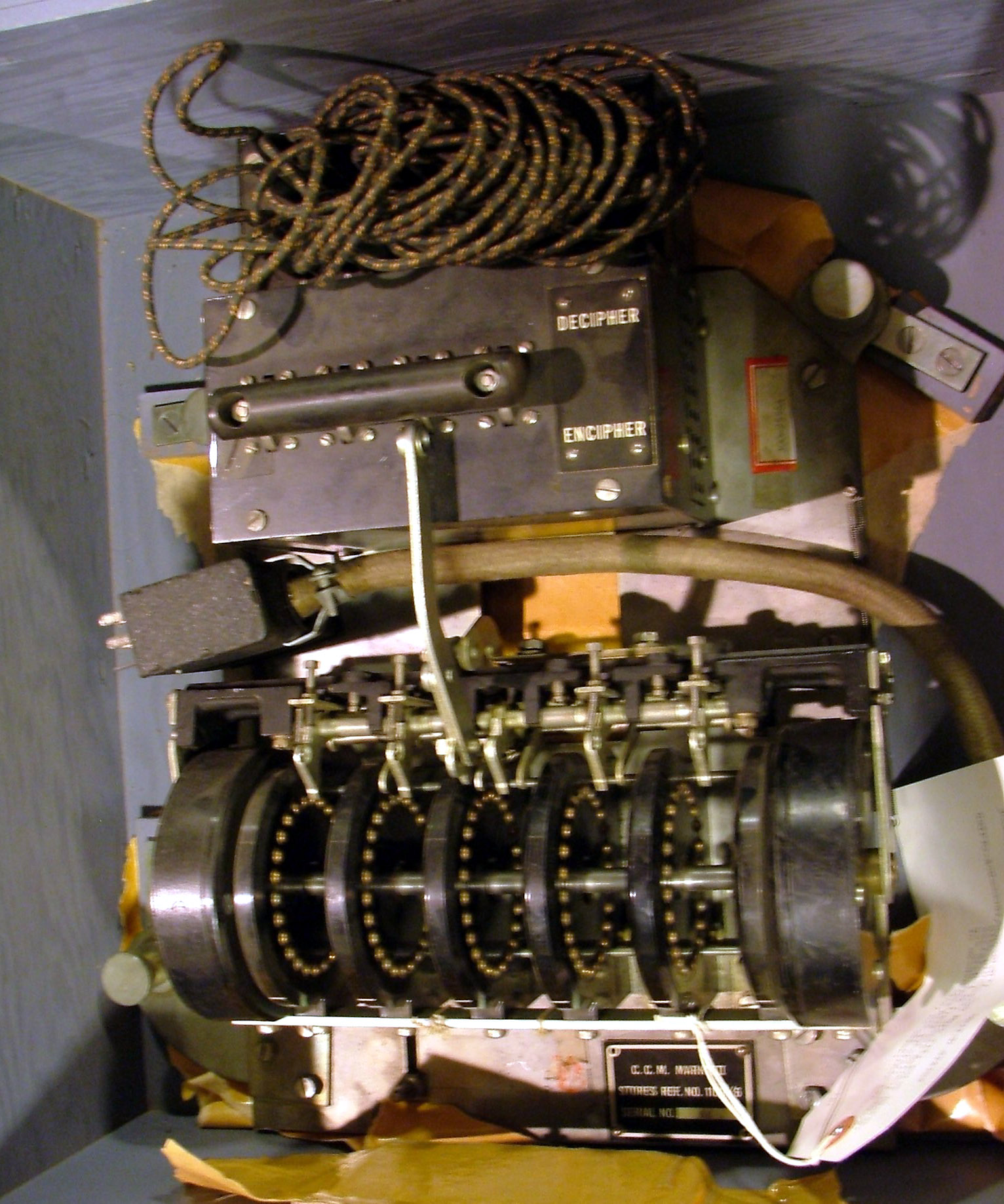The following document, (R.O.) (18-8-44) (N.S. 1041-1-15)
dated August 18, 1944 was obtained from the Canadian War Museum.
R.O means Registered Order and N.S. is the Naval Service file number.
Key excerpts from this document have been posted here. Some of the
original text has been edited in the interest of clarity. It provides some
general information about the CCM Mk II machine, destruction procedures
and actual machine deployments among its Canadian users.
393. Notes on Combined Cypher Machine (C.C.M.) Mark II
* The Combined Cypher Machine is now in force in five Canadian services,
and limited-combined Naval communications between known holders, particulars
of which are given in A.F.O. S.264/44. List of holders of the Combined
Cypher Machine, Mark II, supplied from Ottawa (including serial number(s)
of machine(s) held and particulars of machines held in reserve, are given
in Appendix I of this order.
Subject only to the proviso that Naval Cypher with One Time Pad should
continue to be used for message graded "Top Secret" if a suitable One Time
Pad is held by all the addressees, the fullest use is to be made of the
C.C.M. for all messages which include United States ships or authorities
in the address. Naval cypher, Naval code, Naval shore code and Type "X"
should not be used for combined communications if all ships and/or authorities
in the address of a message are listed holders of the C.C.M.
* The Indicator Lists and Key Lists change automatically in numerical
sequence (unless otherwise ordered) at 0001 GMT on the first day of each
month. Obsolete copies are to be destroyed on the 15th day of the following
month, and destruction certificates rendered.
* Commanding Officers of H.M.C. ships, and other authorities issued
with the C.C.M., should ensure that operators and prospective operators
of the latter make themselves thoroughly conversant with the manipulation
of the machine and use of the associated S.P.s. Operators should take every
opportunity to familiarize themselves with the coding and decoding of specimen
messages until satisfied that they are perfectly familiar and proficient
with these processes.
* The Combined Cypher Machine (C.C.M.) and relevant publications
are to be taken on register charge in C.B. Form R on receipt. The Drums
(Code Wheels) for use with the machine, are supplied in a separate box
and are to be accounted for as a set.
* Reports of machines in Operation or Held in Reserve -It is important
that Naval Service Headquarters should be kept informed of all Combined
Cypher Machines actually in operation, or machines held in immediate reserve
in coding offices, or by Distributing Authorities or Bases for issue.
Twice yearly, on 1st July and 1st January, reports are to be forwarded
to Ottawa. These reports shall include the following:
*Number of machines held, quoting serial number of each. Where
machines are held in different Coding and Cypher Offices at the same base
particulars of machines in each separate office are required.
*Number of above machines in actual operation, quoting serial numbers.
* Whether number machines held is sufficient. If insufficient
number of additional machines considered necessary. If machines are held
in excess of normal requirements, note the number which can surrendered,
quoting serial numbers of machines available for withdrawal and reallocation.
* The fact that a Combined Cypher Machine has been installed and
brought into operation is invariably to be reported immediately to N.S.H.Q.
by signal quoting the serial number of the machine concerned. When
reports are made, routine or special, the serial number of the machine
must always be quoted.
LOGS
A log is to be compiled, in manuscript form, by the holder of every
Combined Cypher Machine. In this log, which is to accompany the machines
when transferred, the following particulars are to be recorded:
1) Serial No. of machine.
2) Date of installation.
3) Date brought into operation.
4) Details of routine inspections carried out, together with any
relevant remarks.
5) Details of repairs adjustments made, including replacement of
spare parts.
6) A daily record of the number of letter-groups enciphered or deciphered
by the machine.
When a machine has completed 250,000 letter-groups, a thorough inspection
and overhaul of the machine is to be carried out, steps being taken to
renew any parts which show signs of excessive wear. The result of this
inspection is to he noted in the log. When a machine has been completely
overhauled at a dockyard or maintenance depot, a sample of the printing
obtained should be pasted in the log.
DISPERSION OF MACHINES
(a) Shore Establishments - a minimum of one machine. Additional machines
will be supplied as requisite, for use in the large offices.
(b) H.M.C Ships. One machine each will be issued to all H.M.C. Ships,
down to and including Bangor Class Minesweepers.
INSTALLATION -The Combined Cypher machine should be installed in
H.M.C. Ships in the Signal Distributing Office or Coding Office, if suitable
accommodation is available, or in a suitable position adjacent to the W/T
Office .
* The machine must be adequately secured in the operating position
to prevent injury or damage due to the motion of the ship.
* Packing and Unpacking.- The C.C.M. Mark II is shipped in a specially
designed packing case. The machine should not be transferred or shipped
without being repacked in the original case and for this reason, the case
should be stowed for future use.
* To unpack the machine, remove the brass screws from the bottom
of the sides of the case, and carefully lift off the top of the case. Set
the machine on its back and remove the shipping bolts. Remove the wooden
base, shipping wedges, etc.
* In view of the fact that the Combined Cypher Machine is the
property of the United States Navy Department and that a number of these
machines have been loaned to the Royal Canadian Navy, it is desired to
impress on all personnel concerned that this equipment will have to be
returned in a satisfactory condition at some future date and, therefore,
should be handled with care to ensure its efficient operation while in
use in the Royal Canadian Navy and suitable condition for ultimate return
to the United States Navy Department.
EMERGENCY DESTRUCTION OF CYPHER MACHINES and ASSOCIATED EQUIPMENT
* The Security of the Cypher Machine system depends largely
on denial to the enemy of knowledge of the internal wiring of the drums
(code wheels) used with the machines. The immediate aim must always be
to so destroy (and if possible entirely obliterate) the internal wiring
of the drums as to make it quite impossible for the enemy to reconstruct
it even should he recover the drum cylinders. This is a matter of paramount
importance, since the consequences which would result through compromise
of a set of drums, or of one or more individual drums comprising a set,
are much more serious and far reaching than would be the compromise of
one or more recoding or recyphering tables. The latter can be replaced
fairly easily, but it would be impossible for a long time to effect a general
distribution of differently wired drums. This fact should be borne in mind
by holders of Cypher Machines and steps should be taken to ensure that
all concerned are aware of the provisions of this Order and are thoroughly
acquainted with the prescribed measures of destruction in an emergency.
The following table shows the order of priority for destruction or
disposal, in an emergency, together with methods of destruction or disposal.
| ORDER OF PRIORITY |
METHOD OF DESTRUCTION OR DISPOSAL |
| Combined Cypher Machine Drums (Code wheels) |
The wiring must be destroyed first. With a
pair of pliers cut the wires as near to the soldered lugs as possible or
if pliers are not immediately available pull the wires out. After removal,
cut the wires into pieces (if time allows) to prevent the possibility of
the wiring being reconstructed. Break up the Code Wheels with a heavy hammer,
as it is essential to destroy the contours in the rims. Scatter the
pieces in a manner which is likely to make recovery impossible or at least
very difficult. At sea, the above procedure should be adopted if time allows,
and the pieces of wire and the Code Wheels should be thrown overboard.
If time does not permit the destruction of the above, the complete
Code Wheels should be thrown overboard singly, in different directions. |
| Note: If circumstances make destruction impossible,
the disposal of a set of drums (Code Wheels) should be carried out in such
a manner as to disperse the individual drums as widely as possible.
The drums should not be disposed of as a complete set. |
1) Current C.C.M. Key Lists
2) Reserve C.C.M. Key Lists
3) Manuals of instructions on the operation and maintenance of C.C.M. |
At Sea:
By (a) burning; (b) placing in "War C.B. Stowage"; (c) locking in
steel chest and leaving chest in place; (d) throwing overboard in steel
chest, perforated iron box or weighted and eyeletted bag.
Ashore: By burning. |
| Combined Cypher Machine Mark II |
The destruction of the machine itself, although
of secondary importance to the destruction of drums and associated
S.P.s, should be carried out if time and circumstances permit.
A heavy sledge hammer or axe should be used in a position adjacent
to the machine and used to demolish the structure of the latter to the
greatest extent possible under the circumstances. Care should, however,
be taken to ensure that any drums in the machine are first re moved and
dealt with as directed above. Alternatively, the machine should be destroyed
by means of an explosive charge. |
* Failing the complete destruction of a machine by means of an explosive
charge, destruction should, if possible, be carried out in such a manner
as:-
(a) To prevent the discovery of the sequence of "stepping" of the
drums (Code Wheels).
(b) To prevent the wiring circuits becoming known.
With this objective in mind, the following procedure should be carried
out if circumstances permit:-
C.C.M. Mark II . -Remove the basket in which the drums normally fit
and break up the control levers and separators. Follow this by smashing
the stepping pawls. If time permits, smash the remainder of the machine
and destroy the wiring.
When a ship is ordered to reduce to a "Dangerous Waters Set" of Books
(see A.F.O. SlO/44, Section XXIII), any Cypher Machine carried should not
be landed [2] unless so directed by the Senior Officer directing the operations
concerned. It is vitally important, however, not to overlook the necessity
for landing the Cypher Machine drums and associated S.P.s listed earlier
in this Order, none of which are included in the "Dangerous Waters Set"
listed in S.P. Form ,A2C (4), paragraph 45.
APPENDIX I
List of Holders of Combined Cypher Machines Mark II, Supplied
from Ottawa
The following is a list of holders of the Combined Cypher Machine,
Mark II, who were supplied from Ottawa, including serial number(s) of machine(s)
held. The list has been corrected to the date of this order.
2. Additions and amendments of this list will be promulgated in Canadian
Confidential Naval Order.
3. Any errors or omissions observed in this list should be reported
by letter to the Secretary, Naval Board. Naval Service Headquarters, Ottawa,
so that necessary amendments may be issued.
4. Four separate lists are incorporated. The serial numbers are also
shown:
List "A" - Shore Authorities including Canadian Army and R.C.A.F.
Argentia Nfld - NIL
Atlantic Command (See Halifax)
Bermuda - S.B.N.O. West Atlantic s/n 105, 106
Bermuda - Somers Isles , H.M.C.S. s/n 790
Canadian Naval Board - (See Ottawa)
Canadian Northwest Atlantic-(See Halifax)
Digby NS area, N.O. I/C - s/n 117
Esquimalt, B.C. N.O. l/C Gaspe, N.O. I/C s/n 203, 204
Gaspe N.O. I/C s/n 2
Goose Bay, Labrador, A.S.O. (Army) s/n 786
Halifax. A.C.R.Q.-S.D.O. s/n 123, 132, 133, 783, 784
Halifax, Dockyard, M.C.O. s/n 3, 4
Halifax, Captain, (D) s/n 10
Halifax, Kings, H.M.C.S. s/n 202
Halifax, Base W/T Maintenance s/n 68
Halifax, G.O.C.-in-C, Atlantic Command s/n 793
Halifax, A.O.C.-in-C, Eastern Air Command s/n 75
Jamaica, Captain-in-Charge s/n 180 192
Montreal, N.O. I/C s/n 120
Ottawa, N.S.H.Q.-S.D.O. s/n 77, 78, 79, 779, 780
Ottawa, N.D.H.Q. (Army) s/n 791
Ottawa, A.F.H.Q. s/n 71
Prince George, B.C. A.S.O. CAnny) s/n 787
Prince Rupert, B.C. N.O. I/C s/n 81
Quebec, N.O. I/C s/n 80
Rimouski, Quebec A/N. C.S.O. s/n 130
St. Hyacinthe, Quebec H.M.C. Signal School s/n
64, 65, 789
St. Hyacinthe, Quebec H.M.C. Signal School (Training
Purposes) s/n 468 to 473
St. John's Nfld. F.O.N.F.-M.C.O. s/n 8, 9, 201
St. John's, Nfld. (Training Purposes) s/n 91, 183
St. John's, Nfld.- A.S.O. (Army) s/n 785
St. John's, Nfld - No1 Groups RCAF s/n 76
Saint John, N.B. N.O. I/C s/n 7
Saint John, N.B. A.S.O. (Army) s/n 792
Shelburne, N.S., N.O. I/C s/n 5
Sydney, N.S., N.O. I/C s/n 6, 782
Trinidad, S.B.N.O. s/n 163, 175
Vancouver, B.C. C.O.P.C. - C.C.O. s/n 83, 121, 135
Vancouver, B.C.- G.O.C.-in-C, Pacific Command s/n 756, 788
Vancouver, B.C. A.O.C.-in-C, Western Air Command s/n 72, 73,
74
Wainwright, Alta.-A.S.O. (Army) s/n 136
Washington, N.M.C.S. s/n 136
Washington, B.A.D.-Naval Signal Registry s/n 69, 70
York Island, B.C.- C.X.O. s/n 82
List "B" - Warships (H.M.C. ship, unless otherwise noted). Serial
number of installed machine prefixes the ship's name.
-A-
51 Agassiz
63 Alberni
568 Algoma
129 Amherst
475 Antigonish
61 Arrowhead
49 Arvida
251 Asbestos
39 Assiniboine
210 Atholl |
-B-
127 Baddeck
16 Barrie
158 Battleford
179 Bayfield
526 Beacon Hill
524 Bellechase
164 Bittersweet
137 Blairmore
240 Border Cities
17 Brantford
138 Brockville
100 Buctoucbe
139 Burlington |
-C-
110 Caldwell, (H.M.S.)
108 Calgary
114 Camrose
199 Canso
215 Cape Breton
197 Caraquet
94 Chambly
234 Charlottetown
515 Cheboque
40 Chelsea, (H.M.S)
567 Chicoutimi
525 Chignecoo
43 Chilliwack
141 Clayoquot
20 Cobalt
244 Cobourg
99 Collingwood
513 Courtenay
189 Cowichan |
-D-
15 Dauphin
625 Dawson
143 Digby
571 Drumheller
147 Drummondville
14 Dundas
22 Dunvegan
205 Dunver |
-E-
245 Eastview
23 Edmundston
145 Esquimalt
102 Eyebright |
-F-
24 Fennel
146 Fort William
50 Fredericton
217 Frontenac |
-G-
53 Galt
144 Gananoque
92 Gatineau
112 Georgetown (H.M.S.).
211 Georgian
182 Giffard
149 Goderich
206 Granby
151 Grandmere
226 Grou (H.M.S.)
243 Guelph
178 Guysborough |
-H-
128 Halifax
26 Hepatica |
-I-
177 Ingonish |
-J-
247 Joliette
239 Jonquiere |
-K-
27 Kamloops
521 Kelowna
109 Kenogami
152 Kenora
153 Kentville
19 King Haakon VII, (HNMS)
58 Kitchener
531 Kokanee
104 Kootenay |
-L-
185 Lachine
241 La Hulloise
55 La Malbaie
59 Leamington (HMCS)
131 Lethbridge
59 Leamington (H.M.S.)
154 Lincoln (H.N.M.S.).
224 Lindsay
196 Port Hope
181 Lockeport
237 Longeuil
235 Louisburg
146 Lunenburg |
-M-
233 Magog
250 Mahone
156 Malpeque
209 Matane
148 Matapedia
93 Mayflower
157 Medicine Hat
184 Melville
30 Midland
159 Milltown
160 Minas
523 Miramichi
31 Moncton
57 Montgomery (H.M.S.)
213 Montreal
572 Moosejaw
98 Morden
161 Mulgrave |
-N-
32 Nanaimo
565 Napanee
519 New Glasgow
527 New Waterford
33 New Westminster
162 Nipigon
194 Noranda
229 Norsyd
214 North Bay |
-O-
62 Oakville
115 Orillia
529 Orkney
95 Ottawa
528 Outarde
220 Outremont
218 Owen Sound |
-P-
245 Peterborough
119 Pictou
212 Portage
116 Port Arthur
520 Port Colborne
126 Prescott
96 Preserver
522 Prince David
530 Prince Henry
207 Prince Rupert
60 Provider |
-Q-
517 Quatsino
168 Quesnel |
-R-
174 Red Deer
125 Regina
89 Restigouehe
103 Richmond, (H.M.S.)
191 Rimouski
223 Riviere du Loup
29 Rosthern
54 Roxborough, (H.M.S).
248 Runnymede |
|
-S-
227 Saint John
166 Sarnia
124 Sackville
84 Saskatchewan
36 Saskatoon
190 Sault Ste. Marie
171 Shawinigan
187 Shediac
113 Sherbrooke
44 Skeena
48 Snowberry
11 Sorel
514 Spring Hill
236 Stettler
221 Stormont
167 Stratford
97 St. Alban's, (H.N.M.S.)
208 St. Boniface
200 St. Catherines
569 St. Laurent
249 Ste. Therese
165 Sudbury
18 Summerside
512 Swansea
216 Swift Current |
-T-
25 The Pas
242 Thetford Mines
170 Thunder
41 Timmins
235 Toronto
169 Trail
198 Transcona
228 Trentonian
38 Trillium
230 Trois Rivieres
172 Truro |
-U-
173 Ungava |
-V-
574 Vancouver
188 Vegreville
56 Ville de Quebec |
-W-
219 Wallaceburg
193 Wasaga
186 Waskcsieu
518 Wentworth
176 Westmount
45 Wetaskiwin
195 Winnipeg |
|
LIST "C"- MACHlNES HELD IN RESERVE
1. Naval Distributing Authority, Ottawa.
